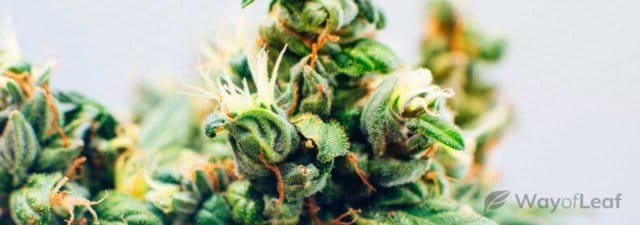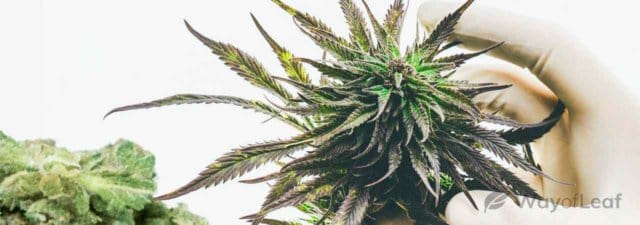If your cannabis leaves have started to turn yellow, you could be panicking right now. Stay calm – there is a solution.
The first step is to diagnose the problem correctly. Cannabis leaves can go yellow for a wide range of reasons, but you can’t solve the problem without knowing the underlying cause. Here is a run-through of several common reasons why the leaves on your marijuana plants might be yellowing, and potential solutions to help you fix it.
Yellow Marijuana Leaves? How to Obtain an Accurate Diagnosis
Scientifically, the yellowing of leaves is called chlorosis. During this process, plant leaves lose their chlorophyll (the compound that keeps them green).
Chlorosis could be caused by a specific issue, such as environmental problems or sunlight deficiency, or it could be caused by senescence—the process of biological aging.
Natural senescence is nothing to worry about. Many plants turn yellow and drop their leaves at the end of each growing season, as we see in deciduous trees during the fall. Some growers “flush” their crops with pure water or a flushing solution at this late cultivation stage. This gets rid of excess nutrients and speeds up the natural process of senescence.
Other factors may also be at play. Rarely, however, is chlorosis a cause for panic. Often, it’s something simple that is preventing photosynthesis.
If you act quickly, you can usually help your plants recover. Here’s how to figure out what’s causing the issue.
Light Deficiency
Lighting can be complicated, especially for new growers. First, you have to establish the correct type of lighting and then figure out the optimal distance from your plants.
Light is crucial because plants need it for photosynthesis. Seedlings need the right amount of light to encourage growth. Young cannabis plants with a light deficiency are likely to turn yellow, whereas mature plants may darken if they’re not getting enough light.
DID YOU KNOW? Young cannabis plants with a light deficiency will turn yellow, while more mature plants will darken.
To help determine if a light deficiency may be your problem, check the nodal spacing (stretches of stem between the leaves) of the newer/smaller leaves on your plants. If there’s more than one leaf-width of space between leaves, inadequate light may be the culprit.
Check out our complete beginner’s guide on the proper lighting for cannabis plants.
The Fix
There are multiple lighting types you should research when setting up your grow:
- LED: These energy-efficient lights are very common and create less heat than other bulbs. Therefore, they’re good for small grow rooms. However, you may need to use a lot of them due to their low power.
- HID: Professionals prefer HID lighting, which is the most intense option available. However, different types of HID bulbs are required for different growth stages.
- Fluorescent: This is another low-cost option for those looking to conserve electricity. They have a low heat output, but they are only useful for small grows.
Strong lights, such as HID (high-intensity discharge) bulbs, are better for cannabis seedlings. Invest in metal halide (MH) or high-pressure sodium (HPS) lights for best results. In a smaller grow room where heating becomes an issue, LEDs are a decent substitute. Also, you may consider moving the lights lower so that they sit closer to your plants. You’ll need to move them as the plant grows taller, though.
Watering Issues
Both over- and under-watering cannabis plants can lead to chlorosis. Unfortunately, water is a tricky thing to get right. You need to water your crop the perfect amount – and at the right times.
Too much water can reduce the oxygen content of the soil, starving the root system and leading to death. You will know if you have overwatered your plants because their leaves will be swollen, droopy, and, yes, maybe even yellow.
Under-watering is less common since most cultivators are hyper-aware that their crop will die without proper hydration. However, under-watering does happen, and under-watered plants may appear weak, thin, brittle, and yellow.
The Fix:
The solution here is simple: stop watering plants that are over-watered, and water under-watered crops more! Get to know your plants well, and get to know the environment they thrive in. Get a feel for the weight of the growing medium when it’s dry, as well as when it’s saturated. You can even invest in a humidity meter to view the water content of your soil more accurately.
By the way, poor soil quality/poor grow medium can also lead to watering issues. Make sure you invest in growing mediums and containers that provide adequate drainage.
pH Imbalance
pH stands for potential hydrogen, and it measures the acidity of a specific medium. pH works on a scale of 1-14, with 7 being neutral. For cannabis plants, the pH of your soil should be between 6 and 7 (hydroponic growers should opt for 5.5-6.2).
If the pH isn’t right, your plants won’t be able to obtain the correct nutrients, and leaves may begin to yellow. We cover nutrient deficiencies in more detail later, but generally, you should note that pH imbalance can cause a variety of symptoms. Yellow leaves, burning at the edges, and marks like spots and stripes are all indications of a pH imbalance.
The Fix:
You can buy a pH tester online to check the quality of your growing medium. Home kits, however, don’t always test for calcium carbonate, which can make your soil heavy in alkaline materials. You can check for its presence by adding a soil sample to a cup of vinegar; if it fizzes, there’s calcium carbonate. Alternatively, send a sample off to a lab.
Once you know the problem, you can either repot in a new growing medium or adjust the soil pH. Certain substances are known to change pH. For example, wood ash and lime can increase it. However, it’s probably a lot easier to purchase pH-up and pH-down substances from a gardening store.
Heat Stress
Heat stress can cause yellow, burnt leaves if plants are kept too close to a light source. Some leaves may also begin to curl.
For lack of a better explanation, this is because marijuana plants (as is the case with most plants) are susceptible to temperature extremes. And again, this often comes down to a lighting issue. Bulbs give off heat while they provide light; put your plants too close to a bulb(s), and you run the risk of frying them.
As noted above, different bulbs can create differing amounts of heat. Fluorescent bulbs are unlikely to cause an issue, but more intense HID lighting can get much hotter.
A quick way to tell whether heat stress is an issue is to use the hand test. Place your hand by your plants and hold it there for thirty seconds. If it’s too hot for your hand, then it’s too hot for your cannabis!
The Fix:
Make sure the light source is the right distance away from your crop. You will need to monitor it and change it regularly as the plants grow. You should also invest in a thermometer. If it’s too hot, then add air conditioning or fans.
Plants that have experienced heat stress may need to be moved away from the light. Keep them at a further distance until they begin to recover.
Nutrient Deficiencies
Nutrient deficiencies are a serious concern for all cannabis growers, but the last thing you want is for your plant to die on account of one – after all, it’s something that’s so easy to fix.
Nutrient deficiencies often end up causing yellow leaves. However, finding an accurate profile of your soil content could require sending it off for analysis. To help you figure out what your crop is lacking, here are some common nutrient deficiencies:
Nitrogen
As one of the most essential plant nutrients, nitrogen is vital in the production of chlorophyll. As a result, a lack of nitrogen will result in yellow leaves. Typically, yellow coloring will appear in older leaves first. Other symptoms include early flowering and fewer buds.
Potassium
Potassium is another vital nutrient. Lack of it will lead to yellow leaves with brown spots on the fan leaves. Some leaf tips may also turn brown and dry out. Curling is also common with a lack of potassium.
Calcium
Calcium binds the cell walls together in plants, making it an essential element for plant structure. Lack of calcium can lead to stunted growth in new structures, and the root tips and young leaves may also grow distorted.
Eventually, the bottom leaves will curl and develop yellow-brown spots.
Magnesium
Magnesium is another element that helps to form chlorophyll. Less magnesium will cause yellow veins in the fan leaves, which eventually curl up and die.
The troubling thing about magnesium deficiency is that symptoms only appear about four weeks after the plant starts to experience a deficiency. Try to keep magnesium levels up throughout growth.
Sulfur
Cannabis plants only need a small amount of sulfur, but a deficiency can still be devastating. High soil pH is often the cause. A sulfur deficiency manifests in yellow fan leaves with stunted growth and frailty.
Zinc
This mineral plays a key role in the production of chlorophyll, among other things. You can spot a zinc deficiency due to wrinkling of the leaves. Often, the leaves will also rotate 90 degrees to the side. The yellow coloration will appear in the leave’s veins.
Iron
Although iron is not a molecule within chlorophyll, it is necessary to produce it. An iron deficiency is easy to spot because young leaves will turn yellow. Eventually, this off-coloring will spread to the veins in older leaves.
Manganese
Manganese deficiency can lead to issues within a plant’s root system. You can detect it because the older leaves will turn yellow.
The Fix:
After identifying the nutrient(s) your plant needs, increase levels by adding it to your soil or growth medium. Try to do this slowly to avoid nutrient shock.
Pests and Insects
Finally, yellow leaves on marijuana plants can occur due to bites from an insect infestation. The exact symptoms depend on the specific pests responsible. However, fungus gnats are a common culprit in triggering chlorosis.
These troublesome insects are likely to appear when over-watering your plant. The gnats won’t eat your plant directly, but the larvae feed on the roots, eventually leading to the yellowing of the leaves.
The Fix:
Kill off insects naturally using measures such as diatomaceous earth, neem oil, and other natural insecticides.
Final Thoughts on Yellow Cannabis Leaves
Whenever you see yellow leaves on your marijuana plants, the first step is not to panic. Yellow leaves are not always a death sentence. Sometimes, the leaves turn yellow for no particular reason, even though there’s no harm to your plant.
In other circumstances, you may need to act to save your crop from complete ruin. If you spot any leaves that are severely wilted and frail, it’s time to defoliate (remove the affected leaves). Make sure you identify the underlying issue so you can address it.
Hopefully, this guide has provided you with some tips to help you save your beloved cannabis plants. Do you have any more tricks to rescue yellowing plants? Drop them in the comments below!


![5 Ingenious Ways to Use Marijuana Trim [Don’t Let It Go to Waste]](https://wayofleaf.com/wp-content/uploads/2020/06/wol_5_ingenious_ways_to_use_marijuana_trim_1920x450-640x225.jpg)


![What Is NPK? [Fully Explained]](https://wayofleaf.com/wp-content/uploads/2019/07/mj_what-is-npk_1920-640x225.jpg)



![8 Tips for Growing Super Lemon Haze Cannabis [Grower’s Guide]](https://wayofleaf.com/wp-content/uploads/2018/10/mj_tips-for-growing-super-lemon-haze-640x225.jpg)


